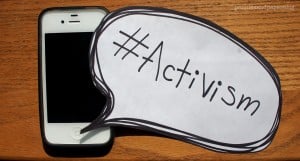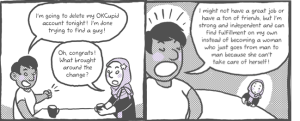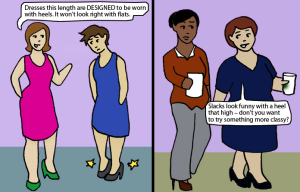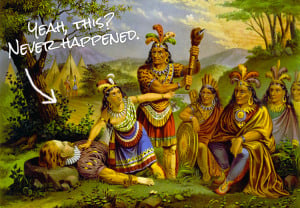
Closeup of a hand filling out a form attached to a clipboard, and an out of focus hand doing the same in the background.
This past April, my mom had a hell of a time trying to vote in the New York Democratic Primary.
A seasoned voter, she went into our local polling place. She had the card she’d received in the mail a week prior, explaining her voting district and where to vote, as well as her state-issued ID, even though New York doesn’t require photo ID cards to vote.
She knew the process well, because she had been voting at the same polling site in a number of previous elections.
Yet this time, she was stopped from voting because her name was not listed.
Polling site volunteers told her that she might have registered for the party too late or that she might be at the wrong polling site.
She explained that she’s been a registered Democrat for over 30 years. She also pointed out her address on her ID, explaining that her apartment was literally across the street from the polling site.
The volunteers told her that they didn’t know what happened, and that her only option was to fill out an affidavit ballot.
Unsure of she could do next, she filled out the affidavit and left feeling frustrated and confused.
She told me, “I had no idea what was happening. Why wasn’t my name on the list this time, but it had been on there before? And why was it there weeks later, when I went to vote in the Congressional primary?”
She was also scared that her vote, with many other votes, was just tossed away.
“I have no idea if my vote was even counted. They just put it in a big envelope and that was that. It didn’t feel confidential at all. I was confused, and I speak English. So many older Hispanics go to that voting site and only speak Spanish. I saw a lot of people just leaving because they didn’t understand what was happening.”
While this might seem like an isolated incident, it was not.
This past April, over 121,000 affidavit ballots were cast in the Democratic presidential primaries, over five times the amount from the 2008 primaries. All over the 5 boroughs, would-be voters reported a number of suspicious activities at the polling sites.
These suspicious activities included: Party affiliations being changed, registrations being erased, missing voter lists, polling sites not opening, missing ballots and wrong or unclear instructions.
Maybe you’ve guessed this already, but the majority of neighborhoods that these problems occurred in were primarily low-income, Black, Latinx, and Asian areas across the Bronx, Queens, and especially Brooklyn.
This incident is far from isolated – it’s an example of voter suppression, which has a troubling history in the United States.
Voter suppression is what happens when legal policy and political groups and organizations actively discourage and prevent many people from voting. In New York and all around the country, there are dozens of examples of voter suppression.
Disenfranchisement is an active and systemic form of oppression. And much like in the past, voter suppression today primarily affects marginalized people.
This is extremely important because the right to vote is one of the most basic forms of civil liberties that all citizens of the United States are supposed to hold. And while many of us are taught that many oppressed groups had to fight for the right to vote in the past, we often don’t discuss how suffrage is still not universal.
Here are 13 examples of voter suppression in the United States.
1. Racist Rules of Citizenship
You must be a United States citizen to vote in federal and state elections. Theoretically, to become a citizen you either have to be born in the United States or go through a naturalization process and be approved.
I say theoretically, because citizenship and suffrage has only ever been guaranteed for white men.
The United States has a very long, racist history of determining who is allowed to be a citizen. And for many People of Color, citizenship did not equal voting rights.
Although Black men were technically citizens and allowed to vote with the Reconstruction Amendments, grandfather clauses, poll taxes, and literacy tests prevented many from exercising this right.
Although they were granted citizenship in 1924, many Native Americans could not vote. In 1882, Chinese Americans couldn’t become citizens and couldn’t vote. By 1922, Japanese Americans and Indian Americans were deemed nonwhite; they were also banned from becoming citizens and couldn’t vote.
And while white women gained the right to vote in 1920, many of them actively protested giving the same right to Black people, in spite of the work of the many active Black women suffragists.
So it wasn’t until the mid-1900s that laws were actively passed for citizens of color to be able to exercise their right to vote. These laws included the McCarran-Walter Act and the Voting Rights Act of 1965.
2. Disenfranchisement of Residents of US Colonies
Today, being a citizen still doesn’t grant you the right to vote.
The Supreme Court passed a law that stated that although Puerto Ricans living on the island are citizens, they do not have the right to vote.
This applies to all of the residents of the US colonies – I mean, territories and commonwealths. They might be citizens, but they’re not allowed to vote in federal elections.
This means that over 4 million people are not allowed to vote for the president and do not have representation in Congress.
The residents of Puerto Rico, Guam, American Samoa, the US Virgin Islands, and the Northern Mariana Islands are all part of the United States and must adhere to federal rules, but have absolutely no say in who is in charge.
3. Disenfranchisement for Folks Convicted of Felonies
According to the Sentencing Project, almost 6 million citizens are banned from voting because they have been convicted of felonies. While the specificities differ from state to state, the majority refuses to grant folks voting rights if they are currently incarcerated, on parole, or on probation.
Maine and Vermont are the only states that allow incarcerated folks with felony convictions to vote. Florida, Iowa, Kentucky, and Virginia don’t allow folks with any felony convictions to vote, regardless of where they are in their sentencing.
Because of the oppressive and discriminatory nature of the United States police and prison system, this primarily affects Black folks and other People of Color.
The Sentencing Project estimates that 1 in 13 Black folks are disenfranchised because of felony convictions.
A 2003 study explains that the trend of actively disenfranchising Black folks through felony convictions was rampant after the 15th Amendment was ratified. The study also found that, “the larger the state’s black population, the more likely the state was to pass the most stringent laws that permanently denied people convicted of crimes the right to vote.”
This shows that banning folks with felony convictions is intrinsically tied to institutional racism. Policymakers explicitly make voter suppression laws that will disproportionately affect Black folks.
4. Voter Identification Laws
34 states have voter ID laws, which essentially state that it’s important for each voter to bring a form of identification so that each person who votes is who they claim to be and only gets one vote. Many legislative bodies claim these laws are used to “curb voter fraud.”
Voter ID laws differ from state to state. Generally, IDs are state-issued such as a driver’s license or a passport, and must have the person’s name and address listed.
There are many problems with this kind of enforcement.
One of the biggest is that voter fraud is hardly an issue in this country. This Mother Jones report found that it’s extraordinarily rare – less common than UFO sightings and getting struck by lightning.
Another is the fact that it can be extremely difficult for marginalized people to obtain these kinds of IDs.
If you’re homeless, it’s difficult to obtain an ID because you don’t have an address. If you’re transgender, it’s a long process to change your name and gender on a state ID. If you’re elderly, documents that are used to obtain state IDs – like birth certificates – can be incorrect or lost.
The process to obtain state IDs is also pricey. If you don’t have the money to pay for ID fees or you can’t take time off to go to the DMV, it’s almost impossible to get an ID.
In some places, DMV offices are so inaccessible that many folks simply go without IDs.
Again, these issues all disproportionately affect People of Color. Many voter ID laws all negatively affect Black, Latinx, and Native populations.
5. Cutbacks to Early Voting
As discussed above, many people can’t afford to take time off from work to go to the DMV.
This also applies on Election Day. Many workers don’t automatically have Election Day off and simply cannot call out of work to go vote.
It might seem like no big deal, taking a few hours out of your day to vote. But it means a lot when you’re an hourly paid worker, a student, or an elderly person, and you have to wait in line for over ten hours in order to vote.
Early voting makes things a lot easier for folks who can’t take off on Election Day. They’re still able to go and vote, but with shorter wait times.
Black voters also use early voting more than white voters. In North Carolina, 70% of Black voters used early voting, as opposed to 52% of white voters.
Unfortunately, some states are cutting early voting and other resources, ensuring that many are left without a way to vote.
6. Lack of Polling Places
For many folks, even getting to a polling place can take hours. This disproportionately affects poor folks living in rural areas.
Some of the people who are most affected by a lack of reachable polling sites are Native Americans who live on reservations.
In one case, the Native citizens of Wanblee, South Dakota have to travel 54 miles round-trip to register and vote in a primarily white town with a racist history.
For others, as mentioned before, it can simply take hours waiting in line to vote. As polling places are cut, there are often too many voters at one site. Besides the long wait, some sites in the primaries have told would-be voters that they ran out of voting ballots.
And it’s not only about wait, or the time it takes to get somewhere (though again, this disproportionately affects folks who can’t leave work). It’s also about not having enough money, reliable transportation, or resources in order to get to your designated polling place.
7. Polling Site Inaccessibility
Under the Americans with Disabilities Act, all community spaces that are used as polling sites must be accessible for all folks with disabilities. This means that all parking lots, passenger drop-off spots, routes to the polling center, building entrances, voting areas, ramps, and elevators have to be accessible for folks with disabilities.
Unfortunately, many polling places are not up to accessibility standards.
A 2012 study showed that in the 2012 Presidential Election, about one-third of voters with disabilities reported difficulty voting.
Another study done on the same election surveyed 900 folks with disabilities and their difficulties voting. 40% of the folks reported physical barriers at the polling places, and 45% of them reported barriers when using voting machines.
Some of these difficulties can include no ramp or elevator, no accessible parking, no Braille or large print ballots, and inaccessible voting booths. In the DMV area alone, 37 out of 140 polling places were not up to accessibility standards.
With all these barriers to voting, folks with disabilities are often denied their right to vote. When your own local polling place isn’t accessible on Election Day, there are few options left.
8. Lack of Non-English Language Resources
According to the 2015 US census, hundreds of languages are spoken in homes across the United States. In New York alone, more than one third of residents speak a language other than English at home.
Back in 1975, the Language Minority Provisions of the Voting Rights Act passed to ensure that all citizens can read and understand voting materials, regardless of their English comprehension. If a voting district has a large percentage of folks whose first language isn’t English, the district must provide alternative materials, which includes translated instructions and bilingual poll workers.
But in reality, the amount of voting materials in other languages doesn’t reflect the diversity of the languages that many Americans speak.
In the 2008 presidential election, Spanish-speaking Latinx voters in Colorado had trouble voting because a lack of bilingual workers and translated materials. This past year, Spanish-language voting guides in Kansas gave out incorrect information regarding registration deadlines.
In a number of cases in Pennsylvania and North Carolina, Asian Americans were not allowed to bring volunteer translators into the poll booths with them. In other cases, poll workers who were not bilingual or culturally sensitive harassed Asian American elders. This has historically been true for many Native Americans as well. Many polling places that Native folks go to have a lack of language assistance and translated voting materials.
It wasn’t until 2015 that the Native American Rights Fund settled a suit against Alaska concerning language resources at voting centers.
9. Voter Purges
The Brennan Center explains that “voter registration lists… are the gateway voting. A citizen typically cannot cast a vote that will count unless her name appears on the voter registration rolls.”
Yet officials can secretly remove registered voters from these rolls, effectively banning them from voting.
In 2014, election officials in 27 states created a program that would remove millions of voters from the voting rolls.
The list, made up mostly Black, Latinx, and Asian voters, works by targeting folks who are believed to have voted twice. Some of the most “heavily weighted” last names are with Jackson, Garcia, Patel, and Kim.
Some officials have tried to pass laws that purge voters who have not voted in previous elections. In 2015, over 40,000 Ohioans, mainly low-income People of Color – were removed from voting lists.
Legal voter purges are often used to “protect” the state against voter fraud. Instead, they erase millions of voters of color from the polls.
There are also multiple examples of thousands of Latinx and Black voters being purged from the polls “mysteriously” and “accidentally.” This occurred not only this past spring in New York, but also in 2014 in Atlanta.
About 40,000 voter registrations vanished – mostly of Black and Democratic voters.
10. Voting Taxes
Voting taxes, or poll taxes, were one of the biggest voter suppression tactics under Jim Crow. They were used mainly in the South to prevent poor white citizens and Black citizens from voting. The Supreme Court originally ruled that poll taxes were constitutional in 1937.
It wasn’t until 1964, when the 24th Amendment was ratified, that poll taxes were prohibited in federal elections. It also took two years for the Supreme Court to rule that poll taxes on any level were unconstitutional.
Almost unbelievably, a number of members of the Ohio House of Representatives sponsored a bill in 2015 that would bring back a type of poll tax. The bill stated that in order to vote, folks would have to show a driver’s license, passport, military ID, or special state voting ID that you must pay for.
If you are obligated to buy something before you can vote, that is a poll tax. And as discussed earlier, it can be extremely pricey and difficult for folks to obtain these kinds of state IDs.
11. Voter Intimidation
Although the Voting Rights Act of 1965 prohibits voter intimidation, folks are still threatened, harassed, and bullied during the voting process.
This has included sending threatening mailers, falsely telling folks they’ll be arrested if they vote, giving false information about polling sites, and giving false information at polling sites.
Intimidators disproportionately target Black people, young folks, and other newly registered voters.
In Kentucky in 2014, various tactics were used to stop people from voting. Mainly young people and Black communities were sent intimidating mailers and advertisements warning people away from “fraudulent” voting.
In 2012, billboards were placed in exclusively Black neighborhoods in Ohio and Wisconsin, warning that voter fraud is a crime.
At the polls themselves, organizations have sent “poll-watchers” to intimidate voters. In 2012, the group True to the Vote sent poll-watchers to monitor Latinx voters in Texas.
Earlier this year, Latinx voters in Massachusetts also targeted at polls. They were illegally asked for ID, denied translation services, and treated with open hostility.
12. Disenfranchisement of Neurodivergent Folks
The Voting Rights Act explicitly says that states are allowed to deny folks the right to vote based on “criminal conviction or mental incapacity.” This means that for neurodivergent folks, the right to vote could be taken away depending on whether or not the state deems them “competent.”
This changes from state to state, but about 30 states have rules or regulations that can limit someone’s right to vote if they have been deemed “mentally incapacitated.” This primarily affects folks with Down syndrome, bipolar disorder, autism, and schizophrenia.
Proponents of this disenfranchisement say it’s so that no citizen is taken advantage of and to stop voter fraud.
But many folks explain that it’s not only a civil rights violation, but it perpetuates stereotypes and harassment of neurodivergent folks at the polls.
In Los Angeles, for example, judges have used literacy tests to determine whether an adult with “limited conservatorship” should be barred from voting. This violates the Voting Rights Act and also the American with Disabilities Act; both literacy tests and banning folks from having assistance in polling sites is illegal.
13. Gerrymandering
Gerrymandering is the “practice of manipulating boundaries of electoral districts for party or class gain.” Basically, elected officials get to redraw electoral district lines to help control who votes in a specific district.
“Racial gerrymandering” is a specific form of boundary-drawing. What it does is create voting districts that spread marginalized people across many different districts.
This is so that there aren’t enough voters in one district to elect their desired officials. Racial gerrymandering was often used to divide Black votes during the Civil Rights Movement.
In the past few years, racial gerrymandering has been used to continue to disenfranchise Black and Native voters.
Earlier this year, the North Carolina legislature had to redraw district lines that had been gerrymandered “along racial lines,” suppressing Black votes.
In states with large Native populations, legislatures use gerrymandering to either “crack” or “pack” districts. Cracking involves separating Native communities across many districts, and packing involves consolidating communities into just one district.
This past June, the Supreme Court agreed to hear a Virginia case about gerrymandering. It is about how much race should be considered when redrawing district lines.
Although race is an important consideration in district lines, it should not be the only deciding factor. As we’ve seen, racial gerrymandering is about dividing racial groups and like-minded voters.
***
We’ve still got a long way to go before “universal suffrage” is a reality in this country.
And as the 2016 Presidential election is coming up, it’s even more important to think about how many people are deliberately kept out of the voting booths. While some voter suppression laws continue to be overturned, we still have a long way to go.
So if you’ve ever complained that political change hasn’t occurred because not enough people are going out to vote, you might need to move back and think about whether or not folks even can or want to vote in the first place. There are many different and valid reasons why someone might choose not to vote.
But for many folks, voting is not as easy as heading over to your local polling place.
[do_widget id=’text-101′]
Jennifer Loubriel is a Contributing Writer for Everyday Feminism and a mixed race Afro-Puerto Rican from the Bronx. She is also a queer mujerista and child abuse survivor. She earned her B.A. from Oberlin College in Religion and English, and identifies as an amateur Latinx ethicist and a speculative fiction enthusiast. She is a co-founder and moderator over at the Tumblr Women of Color, in Solidarity, a safe space for and by women of color. You can usually find her writing about apocalypse and diaspora, rewatching her favorite TV shows, or taking selfies with her family’s cat.
Search our 3000+ articles!
Read our articles about:
Our online racial justice training
Used by hundreds of universities, non-profits, and businesses.
Click to learn more




















